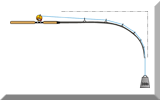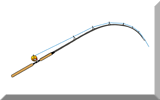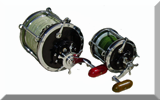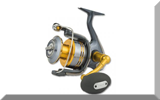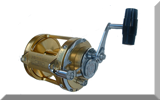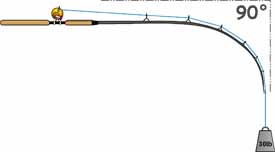Fishing Rod Action, Test Curves
and Line Classes
We often hear fishing rod action described as being 'fast', 'moderate', 'medium' or 'slow'. Clearly it's something to do with the way the rod bends, but what does it mean exactly?
For example, we read about a fishing having 'a lot of power in the mid-sections' or of being 'a bit tippy'. What's that all about?
Or perhaps 'It's a 30lb IGFA class rod'.
Or we might read on the rod blank 'Casting Weight 2oz to 4oz'.
And what about test curves?
Are these ratings all related, and is it something we should all understand?
Let's see...
Fishing Rod Action
A fishing rod's action describes the way the rod bends during casting, or when bringing in a fish.
It isn't a precise measurement, but a general observation as to where most of the rod's curvature is.
For example ...
- a fast action rod will bend mostly in the top third of its length and is sometimes described as a tip-action rod, or 'tippy',
- a moderate, or medium action rod will bend further down its length, typically down to its mid-section, and
- a slow or soft action rod will bend right down into its butt section.
Test Curve
The test curve of a rod is nothing more than the?minimum?load required to bend it through 90 degrees.
In the pic on the left, the 30lb weight is the lightest weight that will get the rod to take up the 90 degree bend, which means that it has a test curve of 30lb.
But that doesn't make it a 30lb class rod.
You didn't really expect it to be straightforward, did you?
If you wish to discover rod's test curve you can do it with a spring balance rather than a selection of weights.
But if you choose to go down this route, TAKE GREAT CARE, as if something lets go a face-full of high-speed spring balance may be coming your way...
Line Class
There are two line class systems that I'm aware of ...
- The UK Class system, and
- The IGFA Class system
These rod rating systems are different, but although both are related to the test curve I'm not sure that you could say that they're derived from it.
The UK Line Class is around 5 times the test curve, so a 30lb class rod will have a test curve of approximately 6lb.
The IGFA Line Class equates to about 2.5 times the test curve, so a 30lb IGFA class rod will have test curve of around 12lb and will be far more powerful than its UK Class equivalent.
Casting Weight
This is the rod manufacturer's recommendation of the optimum lure (or lead) weight to be cast with the rod.
How that's derived isn't clear, but it's probably a function of all the characteristics we've mentioned here, plus a healthy dose of the manufacturers' experience.
and finally ...
So to summarise, power,line class and test curve are related, but different. Fishing rod action is a separate consideration, assessed on how far down the rod the bendy bit extends.
This is not to say that fishing rod action isn't important. It is, because:~
- A fast, tippy action will keep the angler in more direct contact with whatever's on the end of the line - be it a fish or a lure - than will a rod with a medium or slower action.
This is important where lure action and fast hook-sets are needed, which makes them popular for jigging and trolling.
Surf rods designed for use with baitcast reels, where the lead is swung through a wide arc in high energy casting techniques like the pendulum cast, will usually be of this type.
- Medium action rods are required for lighter weights, where a good casting distance is still required.
And surf rods designed for use with fixed-spool (spinning) reels, where casts are made from a standing start require a softer (or more 'through') action, tend towards this type.
- Slow action rods are best for making long, but gentle casts with delicate baits.
|
